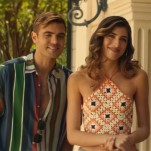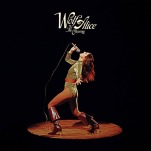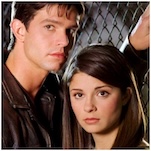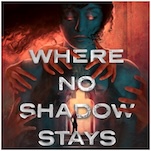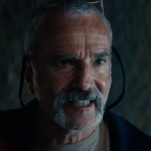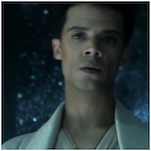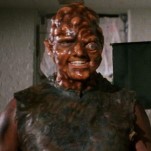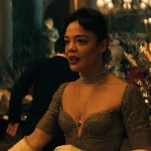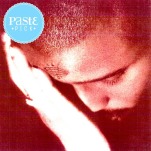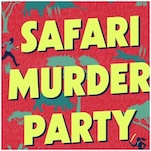100 of the Best Horror Comics of All Time
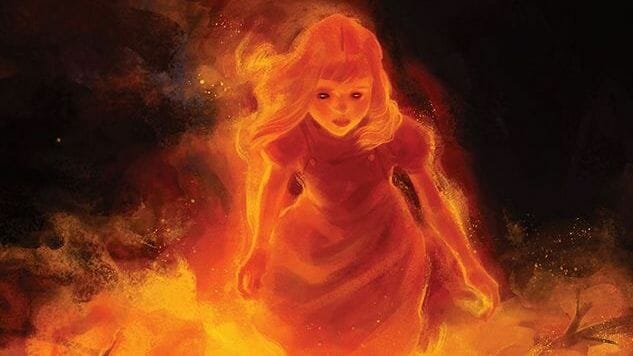
Aided by publishers like Warren and EC, the horror genre built itself into the foundation of sequential art just as vigorously as superheroes, romance or science fiction. When psychiatrist Frederic Wertham published the misguided comics-skewering Seduction of the Innocent in 1954, the moral crusade was in response to the glorious groundswell of murder, corpses and grotesquery on the comics rack. Despite the beating the genre took from the ensuing Comics Code Authority, horror has spent the following decades creeping out of the recesses around mainstream publishing, with Dark Horse, Vertigo, Image, Humanoids and various manga lines filling our nightmares with harrowing new atrocities. In honor of Halloween, this list proudly presents our favorite comic book chillers, thrillers, slow burns and monster mashes, guaranteed to terrify and provoke readers with all the gory gifts this niche offers.
![]()
 30 Days of Night
30 Days of Night
Writer: Steve Niles
Artist: Ben Templesmith
Publisher: IDW Publishing
Every time I read Steve Niles and Ben Templesmith’s grisly vampire yarn, 30 Days of Night, I say the same thing over and over: “How did no one ever think of this genius story before?” The setting? Barrow, Alaska—the top of the world. True to the title, a small population experiences 30 days of continual night during the winter. The vampire horror story writes itself. However, this script comes from the hands of narrative stalwart Steve Niles, one of the masters of modern horror comics, and Templesmith’s cold, brutal artwork fit perfectly. I still get chills every time the coven of vampires make their slow, vicious descent on the townsfolk, unaware of the true horror that’s come for them. —Darren Orf
![]()
 Afterlife With Archie
Afterlife With Archie
Writer: Roberto Aguirre-Sacasa
Artist: Francesco Francavilla
Publisher: Archie Comics
In 2013, the Archie editorial crew took the definition of on-brand and fed it to a ravenous horde of flesh-eating shamblers. Archie Chief Creative Director and current Riverdale showrunner Roberto Aguirre-Sacasa matured Archie, Veronica, Jughead, Betty and the other varsity-jacket icons with a teen rating and a buffet of human organs in this excellent series. Though releases are few and far between, Afterlife hits a note of drama-heavy dread that’s not afraid to veer and twist among an electric ensemble, each character hiding a cemetery of skeletons in their closet. But this churning requiem for youth wouldn’t read so beautifully if not for artist Francesco Francavilla, channeling the dark side of Riverdale in reams of inky shadow. Each panel could be its own Giallo film poster from the ‘70s, the mood coloring echoing director Dario Argento’s hyper-stylized gel lighting. Watching lovable goofball Jughead transform from a burger-devouring lunkhead to a people-devouring lunkhead may be hard to stomach for longtime readers, but it does make for a delicious horror comic. —Sean Edgar
![]()
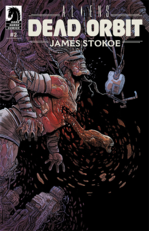 Aliens: Dead Orbit
Aliens: Dead Orbit
Writer/Artist: James Stokoe
Publisher: Dark Horse Comics
Like fellow precision artists Geof Darrow and the late, great Bernie Wrightson, James Stokoe doesn’t stop drawing until nearly every millimeter of canvas is shaded, hatched and stylized. As seen in Orc Stain and his Godzilla runs, a microscope is required to appreciate Stokoe’s images in their hyper-articulate, chiseled depth. In Aliens: Dead Orbit, the cartoonist uses his talent to shape a cosmic graveyard of space junk, dwarfing in scope and mind-numbingly vast. Zoom in tightly enough, and one lone space engineer sits stranded in the wasteland. Though this miniseries utilizes one of the most iconic horror franchises in film history, it builds on its foundation by imposing a sheer sense of scale and futility. Yes, protagonist Wascylewski matches wits with the Xenomorphs and facehuggers, but Stokoe’s art begs what’s the point in a celestial vacuum of hope, light years from any aid. Aliens: Dead Orbit is a Venn diagram of awe, depression and the ghost of salvation, all splayed on 6.63” x 10.24” paper that feels as big as the universe at its most indifferent. —Sean Edgar
![]()
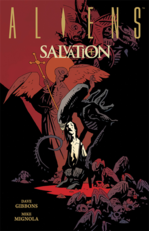 Aliens: Salvation
Aliens: Salvation
Writer: Dave Gibbons
Artist: Mike Mignola
Publisher: Dark Horse
The Aliens franchise has seen a host of worthy comic installments under the purview of longtime license holder Dark Horse, but few have tapped into the oppressive terror of Ridley Scott’s original vision rather than the guns-blazing sci-fi action of the sequels. Written by Watchmen’s Dave Gibbons and drawn by Hellboy creator Mike Mignola (with Kevin Nowlan’s unmistakable inks), Aliens: Salvation pits a pious space traveler against the unrelenting threat of the Xenomorphs. Like an extraterrestrial The Heart of Darkness, the true horror here lies with man’s capacity for violence, not the external threat of a “demon” with multiple mouths. —Steve Foxe
![]()
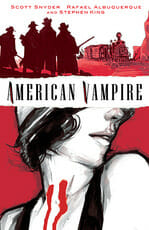 American Vampire
American Vampire
Writer: Scott Snyder
Artists: Rafael Albuquerque, Sean Murphy, Others
Publisher: Vertigo/ DC Comics
Pop-culture depictions of vampires have alternated between sinister predators and brooding romantic figures. Scott Snyder and Rafael Albuquerque’s American Vampire does a fine job of reclaiming the former camp-notably, taking a man who’s terrifying enough even before he develops claws, fangs, and a taste for blood as its central character. —Tobias Carroll
![]()
 Arkham Asylum: A Serious House on Serious Earth
Arkham Asylum: A Serious House on Serious Earth
Writer: Grant Morrison
Artist: Dave McKean
Publisher: DC Comics
Batman stories frequently play at horror—Scott Snyder and Greg Capullo’s long run and Grant Morrison’s own Batman: Gothic with Klaus Janson being prime examples—but Arkham Asylum: A Serious House on Serious Earth is the closest the Caped Crusader has ever come to a full-blown Francis Bacon nightmare. A powerful early mission statement from a young Grant Morrison brought to singularly unsettling life by fine artist (and Sandman cover master) Dave McKean, Arkham is fundamentally a ghost story, even if you ignore the backstory about the manor’s murderous former residents. Locked in the Asylum with his greatest foes, Batman finds himself haunted both by a ghostly pale Joker and by the very Lovecraftian notion that sanity is a brittle, fleeting thing. —Steve Foxe
![]()
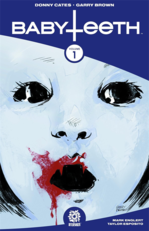 Babyteeth
Babyteeth
Writer: Donny Cates
Artist: Garry Brown
Publisher: AfterShock
As scribe Donny Cates clarified in his interview with Paste, he doesn’t “find the Antichrist compelling whatsoever,” but is completely devoted to exploring “the girl who gives birth to it, and the impact it has on her life.” True to his word, Babyteeth took a progressive twist on the template laid by Rosemary’s Baby, The Omen and House of the Devil. Sex has consistently equated to doom in the horror template, striking a strong argument that the genre is, whether intentional or not, Christian propaganda. The proposition of a woman taking pride and responsibility for her bundle of heresy is a striking and refreshing evolution. Artist Garry Brown’s thick, marker-like lines lend a painterly, analogue touch that wouldn’t feel out of place on a ‘70s grindhouse poster. In these pages, new mama Sadie may face a parade of horror as her son, Clark, fills his unholy legacy, but she’s taking a Mother-of-the-Year attitude while rattling the literal gates of Hell. —Sean Edgar
![]()
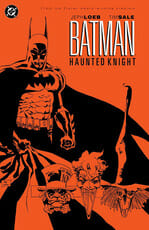 Batman: Haunted Knight/The Long Halloween
Batman: Haunted Knight/The Long Halloween
Writer: Jeph Loeb
Artist: Tim Sale
Publisher: DC Comics
Before working on Marvel’s color quadrilogy, Jeph Loeb and Tim Sale toiled in the deep blacks, blues and grays of Gotham City. The Long Halloween and Haunted Knight paint suffocating visions of Gotham, rendered in Sale’s elegant use of contrast and iconic design. Though Long Halloween tends to receive more attention, Haunted Knight—which consists of three Legends of the Dark Knight Halloween Specials—is an absorbing descent deserving more recognition. The first chapter presents a capable Scarecrow tale, but the sophomore entry shows a young Barbara Gordon trapped in a deranged tea party hosted by the Mad Hatter. A frenzied Jim Gordon lends the narrative a dreadful gravitas, while Sales’s illustrations threaten to consume its heroes in liquid shadows. —Sean Edgar
![]()
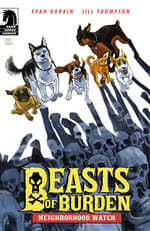 Beasts of Burden
Beasts of Burden
Writer: Evan Dorkin
Artists: Jill Thompson, Benjamin Dewey
Publisher: Dark Horse Comics
This Eisner-award winning series needs an emotional disclaimer: the presence of adorable watercolor animals will not spare you from death and despair, including the demise of some of the aforementioned furballs. Written by Milk & Cheese auteur Evan Dorkin with lush, fully-painted art from Scary Godmother’s Jill Thompson (and, now, Benjamin Dewey), Beasts of Burden follows the “Wise Dog Society,” a band of dogs (and one cat) who protect Burden Hill from a growing evil presence souring the town. Dorkin seems to return to the gang whenever he have a story worth telling, and he and his collaborators know how to spook and tug at the heartstrings in equal measure. The perfect Halloween read for mature kids and grown adults who still get weepy thinking of Old Yeller. —Steve Foxe
![]()
 The Beauty
The Beauty
Writers: Jeremy Haun & Jason A. Hurley
Artist: Jeremy Haun
Publisher: Image Comics
The Beauty requires one hell of a suspension of disbelief to accept its core concept—an STI that makes you sexy overnight—but once you clear that hurdle, this Image series is ideal for horror fans who prefer a police-thriller bent to their chills, à la Silence of the Lambs or I Saw the Devil. Creator Jeremy Haun has been horror-adjacent for most of his career, drawing titles like The Darkness and Constantine, and he taps that vein in his first original series. Alongside co-writer Jason A. Hurley, Haun crafts mask-wearing maniacs and combustible corpses with equal aplomb. The Beauty’s storylines, which feature a more diverse and inclusive cast than average horror fare, have so far been relatively self-contained, working as “seasons” tailor-made for fans of Hannibal ready to take the comic plunge. —Steve Foxe
![]()
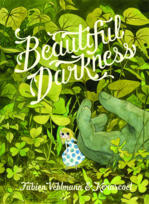 Beautiful Darkness
Beautiful Darkness
Writer: Fabien Vehlmann
Artists Kerascoët
Publisher: Drawn & Quarterly
French import Beautiful Darkness is perhaps more horrific than straight-up horror, slowly unfolding its absolutely bleak miniature world in gorgeous watercolors. Like a classic children’s book straight from Hell, Beautiful Darkness follows a large band of oddly shaped Lilliputians struggling to survive—and constantly, flippantly meeting their violent ends—on, in and around the corpse of a little girl murdered and left to rot in the woods. There are potent metaphors about the human condition and capacity for cruelty at work here, and few comics will leave you as unnerved and inconsolable about our species. —Steve Foxe
![]()
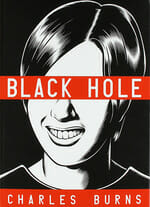 Black Hole
Black Hole
Writer/Artist: Charles Burns
Publishers: Pantheon
Charles Burns’ masterwork is perhaps the apex of body horror, tracing the spread of an STD that mutates its victims. There’s little overt violence and few conventional scares, but the book worms its way into your mind with Burns’ starkly beautiful, woodcut-like images of depravity and teenage confusion, remaining with the reader long after the lights turn off. Picture old-school publisher EC’s horror titles without the narrative neatness or the veneer of humor. —Hillary Brown
![]()
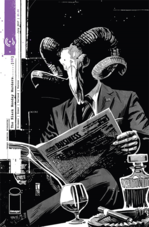 The Black Monday Murders
The Black Monday Murders
Writer: Jonathan Hickman
Artist: Tomm Coker
Publisher: Image Comics
These last few years have offered a particularly gruesome portrait of capitalism’s failings. Bloodied passengers were tossed off planes, companies charged $100 for water in the wake of natural disasters and pharma CEOs put absurd price tags on life-saving drugs. Jonathan Hickman fittingly proposes that the “free market” is the work of the devil in The Black Monday Murders, a layered, labyrinthine comic delivered in stark monochrome by Tomm Coker. The devil has traditionally been the lord of the deal, trading in souls, but this series embraces the larger framework of stocks, recessions and finances alongside its grim goat-skulled demon lord. The world of The Black Monday Murders is unfolding to show different “schools” of warring investment groups and freaky familiars who only speak in symbols, arcanely designed by Hickman. An experience best read in trade-paperback chunks, Coker and Hickman work brilliantly with a corporate aesthetic, delivering whole pages that transform terse emails into omens of doom. This comic is the scariest financial horror story outside of your student loans, with style to spare. —Sean Edgar
![]()
 Bones of the Coast
Bones of the Coast
Editors: Shannon Campbell, Jeff Ellis and Kathleen Jacques
Publisher: Cloudscape Comics
American readers may recognize few names aside from Beyond co-editor Sfé R. Monster and Prophet artist Simon Roy, but Bones of the Coast’s haunting and hauntingly gorgeous brand of Pacific Northwest horror should resonate far outside the bounds of its native British Columbia. By building its anthology around a place rather than a subgenre, Bones of the Coast attracted everything from what-goes-there forest terror to subtle body horror to mythical monsters made real, all bound to the towering trees, rocky beaches and no-one-can-hear-you-scream forests of its corner of North America. Standout stories include a claustrophobic diving trip and a hiking excursion plagued by doppelgangers. —Steve Foxe
![]()
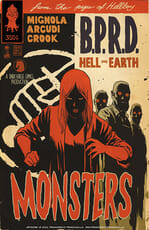 B.P.R.D.
B.P.R.D.
Writers: Mike Mignola, John Arcudi, Others
Artists: Guy Davis, James Harren, Tyler Crook, Laurence Campbell and More
Publisher: Dark Horse Comics
What began as a Hellboy anthology spin-off quickly became the Mignolaverse title most likely to dip into full terror. Mignola’s big, red doomed hero, by nature of being a literal devil with a fist made of stone, is a poor stand-in for genuine horror. The all-too-human members of the B.P.R.D., however, face mortality with much greater frequency. Creep master Guy Davis illustrated the first major chunk of the series, (and designed many of the distinct beasties that populate the book to this day) and the title has seen a murderer’s row of artists pass through since. The most recent runs are some of the bleakest post-apocalyptic scenarios ever committed to the comic page, but new readers can turn to 1946 or Vampire for solid standalone entries. —Steve Foxe
![]()
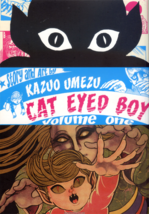 Cat Eyed Boy
Cat Eyed Boy
Writer/Artist: Kazuo Umezu
Publisher: VIZ Media
The Drifting Classroom creator Kazuo Umezu is widely considered to be a godfather of horror manga in his native Japan, and his wide range of appalling talents are on full display in Cat Eyed Boy, an anthology series loosely connected by the presence of the titular half-demon child with piercing feline eyes. The Cat Eyed Boy doles out punishments to the wicked while often taunting the innocent, allowing Umezu to dream up a panorama of terrors ranging from meatball monsters to serpentine stepmothers. One of the most effective tools in Umezu’s arsenal is the Boy’s unknowable moral system: he’s just as likely to invite doom as he is to prevent it, making the two hefty American volumes consistently unpredictable reading. —Steve Foxe
![]()
 Chilling Adventures of Sabrina
Chilling Adventures of Sabrina
Writer: Roberto Aguirre-Sacasa
Artist: Robert Hack
Publisher: Archie Comics
Afterlife With Archie helped revitalize Archie Comics long before Riverdale became a Lynchian cultural phenomenon, but its weird-sister series Chilling Adventures of Sabrina is purer pound-for-pound-of-flesh horror. Both series are scripted by Roberto Aguirre-Sacasa (and both have suffered horrific scheduling issues), but where Afterlife leans on readers’ familiarity with the typically wholesome Archie cast, Sabrina plays its coming-of-age drama straight. Drawn in the style of vintage satanic-panic paperback thrillers by artist Robert Hack, Sabrina melds witchcraft-as-female-sexuality-metaphor with honest-to-Lucifer witchy terror, much like horror breakout film The Witch. There’s depth to the occult goings-on, but Aguirre-Sacasa and Hack don’t skimp on the ritual sacrifice. Don’t settle for the Netflix version alone. —Steve Foxe
![]()
 Clean Room
Clean Room
Writer: Gail Simone
Artist: John Davis-Hunt
Publisher: Vertigo/ DC Comics
Effective horror keeps the audience wondering what will come next. With the Vertigo series Clean Room, Gail Simone has created a world where belief, cults, demons, corporate espionage and multi-dimensional travel all play a part in the lives of both ordinary and extraordinary people, shaping events as they happen. It’s an intriguing look at just how willfully ignorant people can decide to be, and what they chose to do once the scales have fallen from their eyes. Artist John Davis-Hunt and colorist Quinton Winter work together brilliantly to create panels just realistic enough to be truly unsettling when skin starts peeling away, revealing the monsters people hide inside. As the story progresses and the layers peel back, the mystery of what’s really going on only deepens, and the fear only increases. —Caitlin Rosberg
![]()
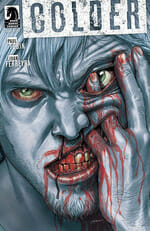 Colder
Colder
Writer: Paul Tobin
Artist: Juan Ferreyra
Publisher: Dark Horse Comics
There’s something devilishly ‘80s about Paul Tobin and Juan Ferreyra’s Colder trilogy, despite its firmly modern setting. Not unlike the Nightmare on Elm Street series or Stephen King’s monumental tome of terror, It, Colder juggles its frights with superpower-like abilities. Protagonist Declan Thomas spends decades in a coma-like state with an ever-dropping internal temperature before awakening with the ability to “cure” madness, which puts him at odds with Nimble Jack, a sort of extra-dimensional jester who feeds on fractured minds. Ferreyra’s soft colors and otherworldly imagination make Colder a visual chiller even if the odds seem stacked in Declan’s favor from the start. —Steve Foxe
![]()
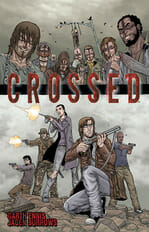 Crossed
Crossed
Writers: Garth Ennis, Alan Moore, David Lapham, Si Spurrier, Kieron Gillen, Others
Artists: Jacen Burrows, Others
Publishers: Avatar Press
Most mass-virus tales are mildly reassuring because the infected’s lacking in the brain department—even if the undead possess super-speed, freak strength or the ability to, somehow, dog-pile over giant walls. That’s not the case in Garth Ennis’ 10-issue series Crossed, which makes it all the scarier. The title features a pandemic that forces the infected to carry out their most-awful urges—rape, cannibalism, murder. Nothing’s off the table in the Crossed world, and its inhabitants are left with the unsettling fact that, at the end of the day, they’re battling against their own wits. —Tyler R. Kane
![]()
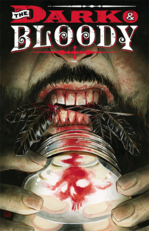 The Dark & Bloody
The Dark & Bloody
Writer: Shawn Aldridge
Artist: Scott Godlewski
Publisher: Vertigo/ DC Comics
Shawn Aldridge and Scott Godlewski’s backwoods chiller The Dark and Bloody is as concerned with real horror as it is with the demonic creature looming just beyond the trees. Iris Gentry is an Iraq War vet, returned to his Kentucky holler and running a moonshine operation out of his garage to provide for his family. When a figure from his past shows up in a threatening new form, Iris is once more thrust into battle to defend his seemingly diminished life. Harrow County’s Tyler Crook provides unsettling covers that perfectly match Aldridge and Godlewski’s work within. —Steve Foxe
![]()
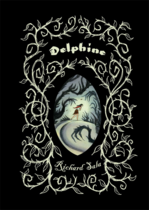 Delphine
Delphine
Writer/Artist: Richard Sala
Publisher: Fantagraphics
Aside from historians, few parties acknowledge that the Brothers Grimm curated some sick, sick, nihilistic folk tales. Predating Disney by 200 years plus, parents cried afoul, pressuring the folklorists into punctuating their tales with far more optimism and happy endings. (For those who disagree, Google “Bluebeard.”) Richard Sala attempts to exceed Jacob and Wilhelm’s Old World gloom in Delphine, the tale of a young man who pursues a beautiful ingénue with a nasty matron looking over her shoulder. Sala’s hatched, angular linework veers from cartoon innocence to black-hole despair within the same page, and any hint of catharsis swirls out of grasp as our “hero” blunders into unfathomable peril. This is a horrific, seductive rendition of Snow White for sadists, with an ending as unflinchingly cold as the frigid landscapes Sala renders. —Sean Edgar
![]()
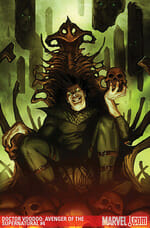 Doctor Voodoo: Avenger of the Supernatural
Doctor Voodoo: Avenger of the Supernatural
Writer: Rick Remender
Artist: Jefte Palo
Publisher: Marvel Comics
Written by a nascent Rick Remender (whose brief stint with a patchwork Punisher in Franken-Castle also makes for a fun Halloween romp) and drawn by Jefte Palo, Doctor Voodoo gave a tantalizing look at the potential of the Marvel U.’s mystical side before being snuffed out at issue #5. Former Brother Voodoo and borderline racist running joke Jericho Drumm isn’t a magic-slinging rookie, but his new role as the Sorcerer Supreme tests him in significant ways. Palo’s rendering of classic Marvel demonic forces like Dormammu and Nightmare bring a new level of intimidation and fear to characters frequently underused by other creators. Voodoo never got a fair shake at owning his new role, but crappy sales and a quick cancellation can’t erase the quality paranormal action of this self-contained story arc. —Steve Foxe
![]()
 The Dregs
The Dregs
Writers: Zac Thompson & Lonnie Nadler
Artist: Eric Zawadzki
Publisher: Black Mask
Black Mask has a habit of combining genre concepts with social awareness, and The Dregs rises to that challenge by flipping the slogan “Eat the Rich” on its decapitated head. The titular Dregs refers to the increasingly boxed-in homeless community in a gentrified Vancouver neighborhood. When yet another of their own goes missing, our bedraggled protagonist—who, like most of the area’s residents, abuses a mind-altering drug that helps him see “patterns” in the architecture and street signs of Vancouver—digs into the disappearances and the coinciding development deal from a high-profile corporation. Co-writers Lonnie Nadler and Zac Thompson and artist Eric Zawadzki operate at the intersection of David Cronenberg and Cannibal Holocaust, never skimping on the entrails or the implications of dining on society’s most overlooked members. —Steve Foxe
![]()
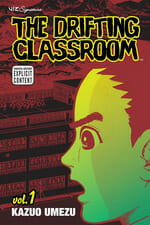 The Drifting Classroom
The Drifting Classroom
Writer/Artist: Kazuo Umezu
US Publisher: VIZ Media
Before James Tynion IV and Michael Dialynas transported an entire high school to a deadly otherworldly forest in The Woods or Dawn of the Dead canonized the cruelty of humanity left to its own devices, manga creator Kazuo Umezu’s twisted mind spawned The Drifting Classroom. Told across 11 volumes, The Drifting Classroom follows an elementary school ripped out of time and space and plopped into a land full of monsters, plagues and the kind of isolation that quickly drives even the most composed teachers and students mad. —Steve Foxe
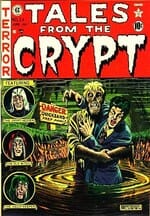 EC Comics Archives (The Vault of Horror, Tales from the Crypt)
EC Comics Archives (The Vault of Horror, Tales from the Crypt)
Writers/Artists: Various
Horror comics as we know them today had to get their start somewhere, and to paraphrase Stephen King’s novelist protagonist in It—who cares if it’s pulp? The archived work found within EC Comics’ vast archives represents a genesis of a few things: iconic imagery, which made these comics culturally recognizable to kids who never snuck under their covers to read them, as well as a more nuanced take on the genre of horror. With most EC collections, you’re guaranteed a spooky, nostalgic trip, as well as a reminder for the bar at which horror comics started. With early readers like John Carpenter and Chuck Palahniuk in tow, you’re in good company. —Tyler R. Kane
![]()
 The Eyes of the Cat
The Eyes of the Cat
Writer: Alejandro Jodorowsky
Artist: Moebius
Publisher: Humanoids
One of the earliest collaborations between El Topo director Alejandro Jodorowsky and Arzach creator Moebius, The Eyes of the Cat is almost more picture book than comic. Much of the storytelling is done by Moebius’ full-page art, and Alejandro’s brief, prosaic exposition is given its own pages. The comic itself is short and simple, and the story’s denouement isn’t even all that frightening. In prose, it wouldn’t carry much weight. But Moebius’ intensely detailed cartooning lends the action a visceral weight that sells it, and reading it in “The Yellow Edition” is even more affecting as it’s printed on yellow paper that happens to be the same hue as rotting, decaying teeth. The impactful imagery—rendered in an aesthetic that is so otherworldly that it appears hyper-real—is mystifying and unforgettable. —Shea Hennum
![]()
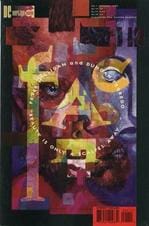 Face
Face
Writer: Peter Milligan
Artist: Duncan Fegredo
Publisher: Vertigo/ DC Comics
It’s a bit cruel to put Face on this list—to the best of our knowledge, this early ‘90s oversized Vertigo one-shot has never been reprinted or collected, nor is it available via Comixology. If not for a mention in Warren Ellis’ excellent newsletter, we might not have ever learned of its existence. It’s a shame Face isn’t more easily obtainable, though; as in Enigma, Peter Milligan and Duncan Fegredo work in perfect unison to flesh out this tale of a reclusive artist and the troubled plastic surgeon he hires for a…project. While not full-blown horror, Face is certainly horrific, combining and almost Poe-like sense of doom with elements of bodily revulsion and a final act that goes full Grand Guignol. If you can’t track down a copy, consider reevaluating Fegredo and Grant Morrison’s Kid Eternity instead. Overlooked among Morrison’s Vertigo prime, Kid Eternity is stunningly painted by Fegredo and offers some genuinely unnerving vistas of Hell alongside a looming serial killer and a bevy of flawed people making bad choices. —Steve Foxe
![]()
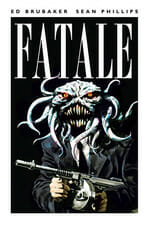 Fatale
Fatale
Writer: Ed Brubaker
Artist: Sean Phillips
Publisher: Image Comics
Noir? Meet horror. Horror? Scare the shit out of every guy who’s attempted to assuage a damsel in distress. In Fatale, dream team Ed Brubaker and Sean Phillips explore the background of a beloved character trope—the wronged, intoxicatingly beautiful lass who visits the hapless rube. Is she evil? Damned? Misunderstood? In the course of 24 issues, the creative team show how the titular character, Josephine, balances all three albatrosses with relative grace throughout the centuries, immersed in bad juju conjured from H.P. Lovecraft and other wondrous, pulpy esoterica. —Sean Edgar
![]()
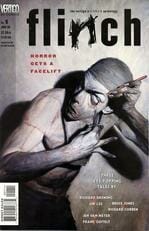 Flinch
Flinch
Writers/Artists: Various
Publisher: Vertigo/ DC Comics
Vertigo’s turn-of-the-century horror anthology is perhaps still the best modern inheritor of the old Eerie and Creepy crowns, with 16 issues of quality terror from legends both established and soon-to-explode, including Jen Van Meter and Frank Quitely, Bruce Jones and Richard Corben, Joe Lansdale and Bruce Timm (who won a Bram Stoker award for their short story “Red Romance”), John Rozum and Cliff Chiang, and more. Short-story collections are always a mixed bag, and some of these tales putter out before they take off (literally, in the case of a Jim Lee-drawn dud), but the thrill of seeing Esad Ribic, Ryan Sook and Berni Wrightson cut loose is enticing enough for Vertigo to finally collect the series in recent years. Bonus: the covers, created by a mix of established comic pros and fine artists, are frequently as scary as the interior pages. —Steve Foxe
![]()
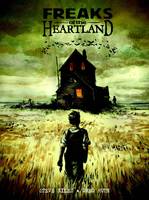 Freaks of the Heartland
Freaks of the Heartland
Writer: Steve Niles
Artist: Greg Ruth
Publisher: Dark Horse
Freaks of the Heartland may be the least romantic X-Men story you’ve never read. If a community of scared, rural everymen and everywomen suddenly produced progeny with misshapen bodies and aberrant powers, they wouldn’t take residence in an upstate New York mansion—they’d be exiled to hidden, dark rooms. Steve Niles and Greg Ruth spin a Southern Midwestern gothic yarn that spans a day but feels like a lifetime. In this taut chase, a circle of misfits and their juvenile siblings flee their parents, who have resorted to silencing their family secrets with a shotgun. Like a cinéma-vérité cross between David Lynch’s The Elephant Man and Stephen King’s Firestarter, this unsettling, yet hopeful, fable offers an emotional dive into the annals of human frailty and ignorance that would make Mary Shelley proud. —Sean Edgar
![]()
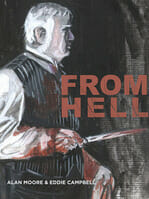 From Hell
From Hell
Writer: Alan Moore
Artist: Eddie Campbell
Publisher: Top Shelf
From Hell overflows with Alan Moore’s obsessions: theories about time, meditations on women’s rights, an intelligent and detached look at the grotesque and, of course, a lot of talking. Within this meticulously researched 565-page tome, Moore and artist Eddie Campbell uncover every facet that could have informed Jack the Ripper’s vicious murder spree through Whitechapel’s prostitute population. Campbell’s rugged scratches create an inhospitable atmosphere of sharp edges and obscurity, leaving the whole picture unclear until Moore unveils his grand explanation, and what an unveiling it is. Whether Jack is a Freemason royal physician attempting to silence a group of blackmailing prostitutes or not, From Hell remains a compelling study of history’s greatest bogeyman. —Hillary Brown & Sean Edgar
![]()
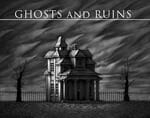 Ghosts and Ruins
Ghosts and Ruins
Writer/Artist: Ben Catmull
Publisher: Fantagraphics
Ghosts and Ruins doesn’t strictly work in panels and word balloons — writer/artist Ben Catmull opts for full-page illustration accompanied by prose — but its content is far and away some of the most creeping, haunting, regal spook strata released by a comics publisher. The book portrays 13 (ha) gorgeously textured, shaded portraits of domiciles where something very, very wrong happened long ago. The plainspoken descriptions pave a path to the gorgeous visuals where the reader’s mind fills in the horrifying gaps. Entry “The Secluded House” features a rectangular farmhouse rooted in an endless meadow, roiling clouds pregnant with rain high above. The text? “All that is known is that any person who ventures closer than this does not come back.” Unfortunately, we can’t help ourselves from venturing into each and every hellish residence in this book. —Sean Edgar
![]()
 Gideon Falls
Gideon Falls
Writer: Jeff Lemire
Artist: Andrea Sorrentino
Publisher: Image Comics
Gideon Falls is one of 2018’s most frightening delights: a dual narrative set between the city and the countryside that explores the urban legend of the Black Barn, a structure that appears throughout history to foretell death and madness. Co-creators Jeff Lemire and Andrea Sorrentino tap into the mounting dread and heard-it-from-a-friend-of-a-friend compulsion of creepypasta stories, with the much more careful hand of experienced storytellers bringing it all to shadow-drenched life. The first arc wrapped up by actually inviting readers into the Black Barn—a discomforting experience that has to be read to be believed. The series, which is headed to television, recently returned with “Original Sins,” a new story arc that delves deeper into the mysteries of the ominous structure and the protagonists drawn to it. —Steve Foxe
![]()
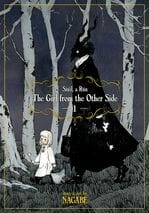 Girl from the Other Side: Siúil, A Rún
Girl from the Other Side: Siúil, A Rún
Writer/Artist: Nagabe
Publisher: Seven Seas
At first glance it might be hard to classify Girl from the Other Side as pure horror. It stars a young girl and the inhuman guardian she calls Teacher, but their days are relatively peaceful, surrounded by nature and revolving around tea parties and meal times. But as the story unfolds, a sense of fearful anticipation creeps into the edges as it becomes clear that Shiva and her Teacher are not what they seem. Humans have built walls to live inside and keep out dark monsters, abandoning Shiva to the wilderness, and Teacher is one of the very creatures that humans fear. If Shiva and Teacher ever touch, she’s doomed to become a monster just like him. As they try to uncover why Shiva has been left behind, they encounter more creatures like Teacher who hint at the role she plays in her own exile. The monster design in Girl from the Other Side is top notch, ranging from humanoid with animal skulls for heads to unsettling amalgams of multiple animals, black slashes on the page full of teeth and unnerving white eyes. Though the story is gentle and sweet it has a sense of building danger with each page turned, waiting for the moment when Shiva accidentally touches Teacher and they finally uncover the truth of who and what Shiva is. —Caitlin Rosberg
![]()
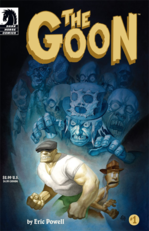 The Goon
The Goon
Writer/Artist: Eric Powell
Publisher: Dark Horse Comics
For sheer pulp exhilaration, depression-era strongman The Goon represents an undeniable high point in comics. Created by writer/artist Eric Powell in 1998, the long-running series follows the titular brawler and his sidekick, Franky, as they duke it out with all manner of the occult, including an unsavory figure known as the Zombie Priest. The Goon may abound with irreverent humor, but it can also dive into bleak austerity, matching the grizzled mood of its main character. The series climaxed with the Once Upon a Hard Time miniseries, bringing the dusty, gothic saga to a bittersweet, emotional end filled with body horror and redemption. —Tobias Carroll
![]()
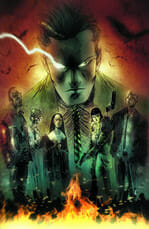 Gotham By Midnight
Gotham By Midnight
Writer: Ray Fawkes
Artists: Ben Templesmith, Juan Ferreyra
Publisher: DC Comics
Gotham By Midnight isn’t the first time the supernatural underbelly of Batman’s municipality has been exposed—remember Steve Niles and Scott Hampton’s Simon Dark? But Ray Fawkes, Ben Templesmith and Juan Ferreyera stretch the city’s borders in weirder, cooler directions than previous scoped, adding some Lovecraftian layers to a city already tortured by organized crime and deranged clown terrorists. An outcast team of detectives (and a nun) lie at the book’s center, inviting deep stories exploring the fringe personalities devoted to keeping the night at bay. Though this series didn’t last long, we at least spent many a rain-drenched night with Sister Justine, Detective Corrigan and a garden full of carnivorous trans-dimensional plants. —Sean Edgar
![]()
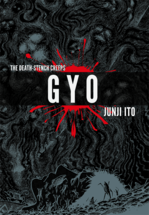 Gyo
Gyo
Writer/Artist: Junji Ito
Publisher: VIZ Media
An undercurrent of black humor runs throughout much of Junji Ito’s work, and nowhere does he play with that contrast as fruitfully as in Gyo. Subtitled The Death-Stench Creeps, Gyo commits dozens of pages to bloated, infected humans essentially farting themselves to death, but any hint of a laugh is dashed when the full scope of Gyo sets in. These gasbags are trapped in mechanical carapaces drudged up from the ocean floor, remnants of some long-ago war effort returned to haunt the living. What at first seems like “only” an invasion of land-bound sea creatures (including the most chilling shark scene to ever take place out of the water) soon turns into an Apocalyptic vision of body horror as only Ito can conjure. —Steve Foxe
![]()
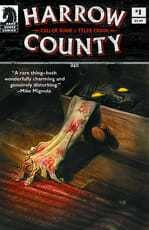 Harrow County
Harrow County
Writer: Cullen Bunn
Artists: Tyler Crook, Carla Speed McNeil, Others
Publisher: Dark Horse
Harrow County is Cullen Bunn’s southern saga of “haints” and witches with stunning art from Tyler Crook, and one of the best books the prodigious writer has ever produced. Bunn’s ear for southern dialect and Crook’s lushly painted artwork are perfectly in sync as the duo pits protagonist Emmy, the strong-willing reincarnation of a powerfully wicked witch, against Bernice, her lifelong best friend who has slowly learned her own form of magic to defend her town and loved ones. Crook, who cut his horror teeth in the pages of B.P.R.D., is the real star of the series, lending life to skinless boys, hulking many-eyed minotaurs and Emmy herself, an often-conflicted young woman with power to spare. Dark Horse has produced some of the industry’s best-loved horror stories over the years, and with the series now complete, Harrow County has firmly established itself within that legacy of lasting terror. —Steve Foxe
![]()
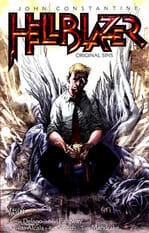 Hellblazer
Hellblazer
Writers: Jamie Delano, Garth Ennis, Brian Azzarello, Others
Artists: Various
Publisher: Vertigo/ DC Comics
Sardonic mage John Constantine has summoned gods, battled demons and conquered cancer. But, for all of its horror and occultist elements, Hellblazer found its scariest moments rooted in reality. Even at its most satirical, Constantine’s exploits always maintained a through-line of realistic subtext. Whether it’s Warren Ellis’ grisly descriptions of domestic decay or Brian Azzarello dropping the smart-ass mage into the American prison system, Constantine’s most frightening encounters have hewn close enough to that kernel of truth to remind readers that real life can be as terrifying as any succubus or demon spawn. —Robert Tutton
![]()
 Hellboy
Hellboy
Writer: Mike Mignola
Artists: Mike Mignola, Duncan Fegredo, Richard Corben, Dave Stewart
Publisher: Dark Horse
Through Hellboy, Mike Mignola explores every inch of the gothic heritage, weaving an ornate tapestry of fiction that stretches from Lovecraft to Shelley to Milton and beyond. What other series can meld mechanical gorillas with Rasputin and Baba Yaga? At the center, one very conflicted, heroic demon battles his destiny as the biggest antagonist of all: the biblical Beast of Revelations. Postmodern awesome aside, Mignola’s art breathes with majesty and mood, etching a profound sense of history and loss through stray panels of crumbling castles and wayward wildlife. —Sean Edgar
![]()
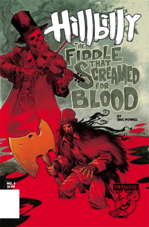 Hillbilly
Hillbilly
Writer/Artist: Eric Powell
Publisher: Albatross Funnybooks
The backwoods assume a sinister new topography in Eric Powell’s Hillbilly, a comic that twists Appalachia into a rural nightmare where witches, demonic snakes and hatchet-wielding loners roam the hills. In its first year, the comic proved just as immersive as the noir underworld of Powell’s previous opus, The Goon, albeit with a heavier fantasy bent. The lore grew with each issue, as blind protagonist Rondel and his bear companion, Lucille, lead the reader further into a mythos that asks, What if Conan the Barbarian had been born in 1910s West Virginia? Of the self-contained tales, “The Fiddle That Screamed For Blood” strikes a high note of ‘80s horror hyperbole with a yarn about a conman musician who curses his violin. Powell often prefers muted greens and browns in his work, but the police-siren red injected into these pages speaks to what every issue of Hillbilly promises: a bloody clash between good and evil. —Sean Edgar
![]()
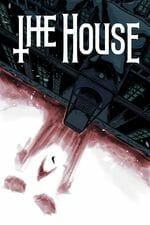 The House
The House
Writer: Phillip Sevy
Artist: Drew Zucker
Publisher: Sucker Productions
For those looking for horror with a slightly historical bent, Phillip Sevy and Drew Zucker’s The House offers an unsettling World War II-era haunted-house horror tale that will leave your skin crawling and the hair on the back of your neck on end for hours afterwards. In the midst of a vicious winter storm, a squadron of United States soldiers stumble on an abandoned mansion in the middle of the woods. Instead of a safe haven, the team are forced to confront their own difficult pasts and an unspeakable evil that poses a far deadlier threat than the snow ever could. Zucker’s art delivers subtle and over-the-top scares in equal measure, with Jen Hickman’s colors creating an eerie ambience that lends a spooky timelessness to the titular house. All seven issues of The House are available on ComiXology now, making this a perfectly sized binge read to get you in the mood for All Hallow’s Eve. —C.K. Stewart
![]()
 House of Penance
House of Penance
Writer: Peter Tomasi
Artist: Ian Bertram
Publisher: Dark Horse
House of Penance is a grand, gothic epic built on a foundation of pupil-dilating art, informed by one of the most bizarre incidents of late 19th-century history. Sarah Winchester—the widow of the man who founded the Winchester Repeating Arms Company—built a sprawling San Jose mansion to house the souls of the Native Americans and soldiers who fell victim to the weaponry her husband forged. Writer Peter Tomasi writes in the constrained, eloquent dialogue of past-century spook slingers M.R. James or Bram Stoker, but artist Ian Bertram wraps the plot in winding, grid-bound tendrils of blood and architecture, conjuring a dwarfing sense of doom that no character escapes. The closest we’ll ever get to a collaboration between Edgar Allan Poe and M.C. Escher, House of Penance is horror that could only be accomplished in comics, and its morbid majesty has to be seen to be understood. —Sean Edgar
![]()
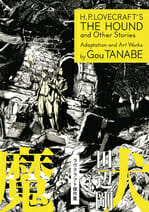 H.P. Lovecraft’s The Hounds and Other Stories
H.P. Lovecraft’s The Hounds and Other Stories
Writers: H.P. Lovecraft, Gou Tanabe
Artist: Gou Tanabe
Publisher: Dark Horse Comics
For all of H.P. Lovecraft’s tentacle-waving impact on pop culture, his actual writing is much more concerned with mounting dread and paranoia than with looming great beasts or complex characters, which is why straight adaptations are much rarer than homage: why stick to the slow madness when you can break out Cthulhu? Gou Tanabe is one of a handful of cartoonists, like British artist I.N.J. Culbard, to tackle Lovecraft stories faithfully, albeit with traditionally handsome manga protagonists rather than the more harried figures you’d expect from a tale of claustrophobic insanity. Dark Horse is the first U.S. publisher to import Tanabe’s work, and hopefully this initial collection will pave the way for the rest of the artist’s Lovecraft series. Too-pretty protagonists aside, Tanabe renders densely detailed scenes full of uneasy shadows, punctuated by moments of abject monstrousness. While horror manga like I Am a Hero and Junji Ito’s classic output benefit from better-realized characters, Tanabe’s take on Lovecraft is a strong tribute to the genre luminary and a fascinating look at how weird fiction can translate to other media. —Steve Foxe
![]()
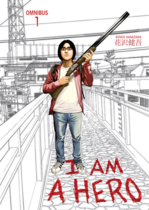 I Am a Hero
I Am a Hero
Writer/Artist: Kengo Hanazawa
Publisher: Dark Horse
Kengo Hanazawa’s I Am a Hero is a welcome shot in the arm for both zombie comics, dominated by industry titan The Walking Dead, and horror manga in translation, a niche almost wholly occupied by Junji Ito. The story, collected in omnibus form by Dark Horse, follow delusional, possibly demented manga creator Hideo Suzuki as a rapidly spreading zombie virus overtakes modern Japan. Hideo is one of the country’s few licensed gun owners, but don’t expect nonstop bullet action—even with crawling corpses swarming around him, Hideo meticulously follows the government’s strict regulations on firearms, so as not to “spoil it” for everyone else. Hanazawa paces the story more like a classic American horror film than a frantic manga tale, relishing each gory encounter and frequently employing a fisheye effect to his hyper-detailed style to make his violent cannibals that much more unsettling. With moments of absurd humor, commentary on a host of Japanese cultural issues and genuinely terrifying flesh-eaters, I Am a Hero is one of the best modern horror comics from any continent. —Steve Foxe
![]()
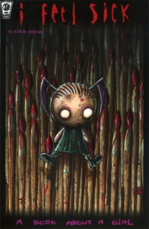 I Feel Sick
I Feel Sick
Writer/Artist: Jhonen Vasquez
Publisher: Slave Labor Graphics
Technically closer to an absurdist dark comedy than a conventional horror story, I Feel Sick chronicles the misadventures of Devi, one of the only supporting cast members to survive Johnny The Homicidal Maniac. Devi quits her bookstore job to paint sci-fi novel covers. Unfortunately, the more-lucrative employment situation doesn’t pan out smoothly. Devi starts receiving uncontrollable and inexplicable static shocks, and an unfinished painting of a purple-haired doll starts telling her to do bad stuff. Making matters worse, she can’t meet a dude without him turning out to be a mass murderer or a chronic pants-shitter. —Barry Thompson
![]()
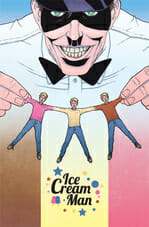 Ice Cream Man
Ice Cream Man
Writer: W. Maxwell Prince
Artist: Martin Morazzo
Publisher: Image Comics
Though Kickstarters and independent publishing abound with anthology comics, larger publishers hesitate to embrace the non-sequential storytelling that affords creative teams and readers opportunities to dive in and out of narratives at will without losing track of what’s going on. Ice Cream Man is one of the few titles to buck that trend, as the trio of W. Maxwell Prince, Martin Morazzo and Chris O’Halloran deliver unexpected and compelling stories in each issue with only minimal connection between unsettling installments. Comparisons to The Twilight Zone are entirely earned: each issue offers up a new horror, linked by a single man who weaves himself into the story while offering up only hints at his real role in the proceedings. The sixth issue in particular marked a new kind of experiment: a single narrative with three different concurrent perspectives and the appropriate title of “Strange Neapolitan.” Diving in for this single issue as a sampler should be easy, but readers who do will likely want to go back to read each off-kilter tale. —Caitlin Rosberg
![]()
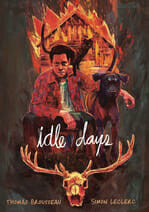 Idle Days
Idle Days
Writer: Thomas Desaulniers-Brousseau
Artist: Simon Leclerc
Publisher: First Second
While publisher First Second has a reputation for all-ages comics, their publishing slate is one of the most varied in the industry, with books like Idle Days existing several steps removed from bright-and-bubbly middle-grade fare. Protagonist Jerome is a military deserter in WWII Canada, hiding out at his grandfather’s remote farm in the wake of his father’s violent death. The guesthouse and the woods around the farm both drip with menace, the reverberations of dark deeds of the past. Simon Leclerc’s impressionistic, painterly artwork dives headlong into the autumn and winter colors of rural Canada, bringing to mind the golden days of painted Vertigo comics by the likes of Kent Williams, Duncan Fegredo, Dave McKean and John Bolton. As the seasons continue to turn, Idle Days is an ideal, menacing-if-perhaps-not-outright-horror read. —Steve Foxe
![]()
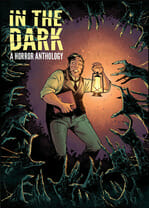 In The Dark
In The Dark
Editor: Rachel Deering
Publisher: IDW Publishing
A Kickstarter smash before IDW picked it up for wider distribution, In The Dark captures fright tales from a who’s who of the hardest working creators in the industry: Cullen Bunn, Justin Jordan, Declan Shalvey, Tradd Moore, Paul Tobin, Tyler Jenkins, Tim Seeley, Steve Niles, Marguerite Bennett (who went on to expand her story InSeXts with artist Ariela Kristantina for publisher AfterShock Comics), and some dude named Scott Snyder. Compiled and edited by writer, letterer and horror aficionado Rachel Deering, In The Dark, like any anthology, is inconsistent, but its claws are sharp and deadly more often than not. —Steve Foxe
 Infidel
Infidel
Writer: Pornshak Pichetshote
Artist: Aaron Campbell
Publisher: Image Comics
Former Vertigo editor Pornsak Pichetshote’s writing debut updates the haunted house for the MAGA era, as a young Muslim woman and her multiracial neighbors move into a building stalked by spirits that feed off of xenophobia and racism following an explosive attack that claimed the lives of several residents. Like a literary cousin to Get Out, Infidel pulls from the modern tumult to tell a thrilling genre story the way that only sequential art can, enhanced by Aaron Campbell’s shadowy style, which pulls off some of the most genuinely unnerving spirits in sequential-art memory. —Steve Foxe
![]()
 InSEXts
InSEXts
Writer: Marguerite Bennett
Artist: Ariela Kristantina
Publisher: AfterShock Comics
Romance and horror don’t often go hand in hand, but trust innovative comic scribe Marguerite Bennett to find a way to make it work. InSEXts revolves around two women, lovers creating a family of choice in Victorian London, struggling against oppressive social expectations and controlling men. Bennett deftly uses monstrousness as a metaphor, both leads changing into insect-like creatures to protect themselves and others. The writer clearly draws parallels between Victorian sexism and today’s misogyny, giving her characters agency and a right to use violence that most female-centered comics shy away from. It’s Metamorphosis with a decidedly aggressive, feminist bent, and all for the better. —Caitlin Rosberg
![]()
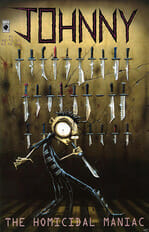 Johnny the Homicidal Maniac
Johnny the Homicidal Maniac
Writer/Artist: Jhonen Vasquez
Publisher: Slave Labor Graphics
At its core, JtHM is a coming-of-age story in which the titular Johnny (“Nny,” for short) ultimately curbs his all-encompassing, homicidal fury. The final page of the The Director’s Cut collection hints that Nny could grow into a somewhat-adjusted, productive member of the world. That said, he kills many, many innocent-ish people in unspeakably gruesome, though inspired, ways before experiencing anything resembling an epiphany. He also has to die, inadvertently unmake all of existence and take underwhelming sojourns to both Heaven and Hell. The success of this seven-issue series—required reading for depressed teenagers in the ‘90s—led to Nickelodeon inviting Vasquez to create the far-less-grisly Invader Zim cartoon. —Barry Thompson
![]()
 Kill the Minotaur
Kill the Minotaur
Writers: Christian Cantamessa, Chris Pasetto
Artist: Lukas Ketner
Publisher: Skybound/ Image Comics
Ancient civilization was harrowing enough with rampant disease, invading armies and other survival rigors that kept the mortality rate competitive. The horrific beasts of Greek mythology were endemic of the age’s perpetual strife, even for a society far more advanced than its global peers. Christian Cantamessa, Chris Pasetto and Lukas Ketner warp the epic sensibilities of Homer and Virgil with the creature-feature morbidity of Clive Barker in Kill the Minotaur, a comic that straddles the tightrope between grandiose and ghoulish. The miniseries takes the myth of the bull-headed monstrosity locked in a labyrinth and ups the budget and blood. Athenian prince Theseus is cast into an intoxicatingly large prison where an atrocity much larger and aggressive than a male cow preys on his sacrifices. Ketner preserves the elegiac glory of centuries past with striking architecture before filling his spaces with twisted designs that transcend nightmare fuel. Kill the Minotaur is a rare project that blends the high adventure of Ray Harryhausen with the striking imagination of ‘90s fantasy horror, disorienting the reader in a maze of twists and gore. —Sean Edgar
![]()
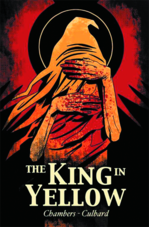 The King in Yellow
The King in Yellow
Writers: I. N. J. Culbard, Robert Chambers
Artist: I. N. J. Culbard
Publisher: SelfMadeHero
I. N. J. Culbard’s H. P. Lovecraft adaptations—The Dream-Quest of Unknown Kadath, At the Mountains of Madness, The Case of Charles Dexter Ward and The Shadow Out of Time—are the rare visualizations of the Cthulhu creator’s work that capture the unknowable essence of cosmic horror without sacrificing the dense, archaic style that makes Lovecraft so frustratingly singular. The much more fluid prose of Robert W. Chambers, a contemporary of Lovecraft, translates even more chillingly to sequential art in The King in Yellow, a classic of weird fiction revived in the public eye by its influence on the HBO series True Detective. Culbard’s clean cartooning and knack for period details (also on display in the Vertigo series The New Deadwardians) perfectly fits Chambers’ interlocking tales of a play that drives people mad. —Steve Foxe
![]()
 Locke & Key
Locke & Key
Writer: Joe Hill
Artist: Gabriel Rodriguez
Publisher: IDW Publishing
Putting aside Joe Hill’s well-documented genetics (he’s the son of Stephen King), the strength of the short story collection 20th Century Ghosts and novels like Horns and NOS4A2 offer more than enough proof that the man can pen a frightening yarn. Throw in Gabriel Rodriguez’s thoroughly unsettling artwork and you have Locke & Key, a modern horror-comic classic centered around a haunted New England mansion and the family that suffers through its supernatural torments. And while the series, with its focus on crafting a fascinating mythology about magical keys wrought from demonic metal, quickly proved it had more on its mind than simply scaring the reader, it certainly was never lacking in the fright department. —Mark Rozeman
![]()
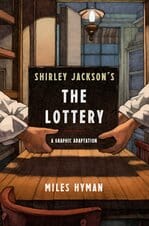 The Lottery: The Authorized Graphic Adaptation
The Lottery: The Authorized Graphic Adaptation
Writers: Shirley Jackson, Miles Hyman
Artist: Miles Hyman
Publisher: Hill and Wang
“The Lottery” is probably one of the most famous horror short stories ever, taught in classrooms and familiar to even those who don’t consider themselves fright fans. Shirley Jackson is one of the most skilled writers of the genre, relying on tension and anticipation to propel readers through her stories, but that can be difficult to translate into a visual medium. In the foreword to the graphic adaptation, Jackson’s own grandson Miles Hyman discloses his longtime hesitation to tackle one of his grandmother’s most famous works, but the care he takes with the subject elevates the book to incredible places. Hyman’s art is detailed and painterly, with echoes of Norman Rockwell and hand-painted advertisements that perfectly suit the late 1940s setting in which Jackson and Hyman both set their scenes. Colors are deceptively bright and characters look wholesome and nostalgic, like they should be welcoming and kind, a sort of Pleasantville bait and switch that helps the book stay true to Jackson’s story. The building sense of discomfort and dread that permeates Jackson’s prose is clear in Hyman’s art, dialog sparse at first but coming faster and more tightly packed as characters start to bow to fear. Even readers who know Jackson’s short story well can enjoy the graphic novel, a true-to-tone adaptation built on the strong bones of Jackson’s work. —Caitlin Rosberg
![]()
 Moonshine
Moonshine
Writer: Brian Azzarello
Artist: Eduardo Risso
Publisher: Image Comics
Mixing lycanthropy with prohibition-era crime, Moonshine marks the first time the 100 Bullets duo of Brian Azzarello and Eduardo Risso have collaborated under the Image banner, which let them off the leash with regard to fur-and-fangs violence rendered in Risso’s singularly masterful noir style. Werewolves, for all their long legacy in the horror genre, are notoriously difficult to do right—or to make scary, given how they’ve shifted over the years from nascent body horror to primal-power wish-fulfillment. Azzarello and Risso manage to straddle the line between their wolves being both bloody murder machines and a cursed existence for those afflicted, and have never once lost sight of the men and women beneath all the hirsuteness. —Steve Foxe
![]()
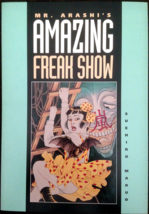 Mr. Arashi’s Amazing Freak Show
Mr. Arashi’s Amazing Freak Show
Writer/Artist: Suehiro Maruo
Publisher: Blast Books
Mr. Arashi’s Amazing Freak Show isn’t easy to obtain these days, but it’s essential reading for horror-manga fans with strong constitutions. One of the few ero guro (“erotic grotesque”) works officially released in translation, Suehiro Maruo’s brief tale of a young girl whisked out of poverty by a traveling sideshow and thrust into a world of physical and emotional abuse isn’t for the faint of heart. Easily more transgressive than the work of Junji Ito or Kazuo Umezu thanks to its perverse sexuality (including underage characters), Mr. Arashi’s Amazing Freak Show draws inspiration from 1920s Japan and the bloody tradition of Muzan-e art to gorgeously portray its abject cruelty. If you’re searching for the next plateau of disturbing horror, this may be it—but be warned that you can’t unsee what’s in this sideshow’s tent. —Steve Foxe
![]()
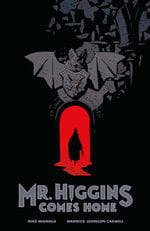 Mr. Higgins Comes Home
Mr. Higgins Comes Home
Writer: Mike Mignola
Artist: Warwick Johnson-Cadwell
Publisher: Dark Horse
Mike Mignola returned to comics for the first time after wrapping Hellboy in Hell with a charming, British homage to Hammer horror films and sexy bloodsuckers. This slim graphic novel follows two vampire hunters who attempt to coax the title figure back to Castle Golga, a grand manor where untold horrors befell Higgins decades before. Mignola takes a slightly lighter tone with moments of abrupt humor, including a community-theater-grade devil summoning. Johnson-Cadwell matches that buoyant atmosphere with storybook illustrations of frivolous, ornate pomp. His castle is a cluttered museum of off-angle portraits, bizarre taxidermy and ancient weapons, and his character designs are delightful—-body shapes range from anchor-heavy round torsos to looming telephone-poll counts. And whereas Hellboy relied on stark blacks and grays contrasted against bright red, these panels swim in whites and blue, purples and aquas, sea-greens and browns—a kaleidoscope of Gothic splendor. At 49 brisk pages, Mr. Higgins Comes Home could stand to be longer, and certainly didn’t need the hardcover treatment, but it does offer a whimsical sample of shadow-steeped opulence rendered through ‘60s pop culture. —Sean Edgar
![]()
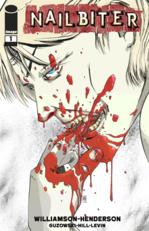 Nailbiter
Nailbiter
Writer: Joshua Williamson
Artist: Mike Henderson
Publisher: Image Comics
Nailbiter takes the mystery inherent to serial killer tales and ups the ante. In a town known for birthing more than a dozen of the world’s most infamous murderers, there’s no shortage of potential mayhem. Methods of murder in Buckaroo, Oregon, are creative to say the least, and the lines between predator and prey grow ever blurrier. Whether it’s a “reformed” killer butchering a cow or a mutilated-corpse crucifixion, writer Joshua Williamson offers up gory scenarios worthy of Herschell Gordon Lewis and artist Mike Henderson splatters down the blood and guts. —Robert Tutton
![]()
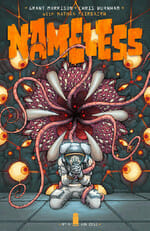 Nameless
Nameless
Writer: Grant Morrison
Artist: Chris Burnham
Publisher: Image Comics
Every so often, metaphysics elder statesman Grant Morrison pops his collar, sneers and turns his back on happy endings. In Nameless, Morrison pens a cosmic tale of universal body horror that masturbates over the demise of humankind. The plot volleys a space crew at none other than god, its biblical biography repositioned to reveal a malignant superpower devoted to our collective despair. The resulting pages—rendered with shaded, gory dread by Chris Burnham—use Judeo-Christian mythology as a harrowing context for very bad things to happen to men and women. Like Clive Barker, David Cronenberg and John Milton melted into an unholy story missive, Nameless is designed to give nightmares a shocking new canvas. —Sean Edgar
![]()
![]() Neonomicon
Neonomicon
Writer: Alan Moore
Artist: Jacen Burrows
Publisher: Avatar Press
Alan Moore is a comics genius in every sense of the word. He redefined the superhero, wrote some of DC’s most seminal stories and created enduring classics that will long serve as examples of what the medium strives to be. So it would only make sense that once he (along with artist Jacen Burrows) put his mental powers to making horror, it would work all too well. Rarely have I stopped reading a book, not because it wasn’t good, but because I was actually too scared to finish it, too frightened to turn the page and see what images would assault my retinas. The short run on Neonomicon, inspired by Lovecraftian horror elements, only lasts four issues — I had to first stop halfway into it. Neonomicon is relentless, unforgiving, and scary as hell. —Darren Orf
![]()
 Nijigahara Holograph
Nijigahara Holograph
Writer/Artist: Inio Asano
Publisher: Fantagraphics
Don’t judge Inio Asano’s graphic novel, Nijigahara Holograph, by its glowing butterfly cover, assuming that what lies within is sweet or sentimental. Pay attention to your gut instincts, which should pick up on all of the unnerving peripheral imagery: the silhouette of a young girl stands shin-deep in flowing water. Her hair snakes up in creepy tendrils, framed against the light that floods the world outside a sodden tunnel. The scene suggests immediate danger and horror, which is exactly what the following pages contain in this tale of a group of teachers and pupils who intersect in harrowing ways. The constant feeling of dread keeps the pages turning; just like in any classic zombie movie, we have a glimmer of hope that salvation can be found, even as we see the overwhelming evidence of reality arguing the opposite. —Hillary Brown
![]()
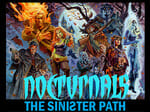 Nocturnals
Nocturnals
Writer/Artist: Dan Brereton
Publisher: Dark Horse/ Image Comics/ Oni Press
More than two decades old, Dan Brereton’s Nocturnals remain as sexy and sleek a group of monsters as can be found in the genre. Doc Horror and his daughter, Evening, lurk on the escapist edge of the macabre, borrowing from the pulpy fun of ‘50s drive-through esoterica. The duo and their circle of supernatural outcasts—including an aflame swordsman and human/reptile hybrid—fight dimension-hopping monsters and evil DNA-warping corporations. Brereton’s singular style renders the spooky with catwalk finesse, fully painted characters defined by sunken cheeks and nuclear gazes like some unholy hybrid of Tim Burton and Andy Warhol. —Sean Edgar
![]()
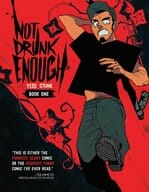 Not Drunk Enough
Not Drunk Enough
Writer/Artist: Tess Stone
Publisher: Oni Press/ Webcomic
It can be difficult to inject horror stories with personality. Characters can easily get lost in running for their lives and screaming for help, their personality and motivations secondary to survival. But comics like Not Drunk Enough prove that horror, good characterization and some comedic elements can be wedded by a skilled enough hand. Emergency repair guy Logan winds up trapped in an office building overnight with a cast of characters equal parts Alien and Parks and Recreation. They struggle to survive the monsters that have taken over the place, the result of a mad scientist’s experiments and corporate shenanigans. Even after they’ve escaped from the immediate danger of the office, Logan and his new friends haven’t quite escaped the monsters or the men who allowed them to be created in the first place. Tess Stone’s art is kinetic and sketchy, and his lettering and effects are particularly fun, with Logan’s overblown expressions leaping right off the page. What’s particularly gratifying about Not Drunk Enough is the through-line of grief and family tragedy that Stone has woven into the story; as Hereditary and Haunting of Hill House have shown, this is the year for horror storytelling about these sensitive subjects, and Stone absolutely delivers. —Caitlin Rosberg
![]()
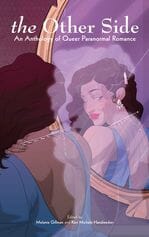 The Other Side: An Anthology of Queer Paranormal Romance
The Other Side: An Anthology of Queer Paranormal Romance
Editors: Melanie Gillman & Kori Michele
Publisher:Other Side Press
If love is dead, maybe that’s not so bad. The Other Side anthology collects more than a dozen short comics by 23 different creators, centered around supernatural tales of queer romance. There’s a little something here for anyone—tales of loss, tales of transformation, tales of ghostly pizza boys bound to terrible bosses for eternity (Laurel Varian and Ezra Rose’s “Third Circle Pizza” makes the entire anthology worth it). The anthology’s contributors deliver tales centering queer characters in both haunting and haunted situations alike, exploring the supernatural with more nuance and variety than queer comics readers often have the opportunity to enjoy. This anthology may not be the scariest entry here (though there are some eerier stories, like Margaret Kirchner’s gorgeous “Tierra Verde”) but who says all spooky romances have to be tragic? —C.K. Stewart
![]()
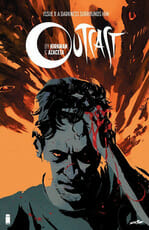 Outcast by Kirkman and Azaceta
Outcast by Kirkman and Azaceta
Writer: Robert Kirkman
Artist: Paul Azaceta
Publisher: Skybound/ Image Comics
It’s typically a warning sign when a comic is optioned for film or television before its first issue hits stands, and Outcast by Kirkman & Azaceta also launched in the shadow of Kirkman’s other horror story, the juggernaut The Walking Dead franchise. Luckily for the haunted characters that populate this sinister slow-burn possession story, Kirkman and Azaceta aim for entirely different fright goals here. It’s cliché to compare a scary story to Stephen King’s body of work, but Outcast by Kirkman & Azaceta’s cast of complicated, deeply flawed characters brings to mind ’Salem’s Lot’s tableau of small-town unease, with the same looming sense of doom gathering overhead like a dark cloud. Kirkman doesn’t sound like Kirkman here, a feat at this point in his established career. —Steve Foxe
![]()
 Panther
Panther
Writer/Artist: Brecht Evens
Publisher: Drawn & Quarterly
Brecht Evens didn’t need blood or bogeymen to create the most disturbing graphic novel of 2016. Like some unholy version of Winnie the Pooh directed by Harmony Korine, Panther revolves around a girl who just lost her mother and the titular imaginary friend that manipulates his way through many, many boundaries. Always implied and never stated, the book’s horrors dance around pedophilia and exploitation as Panther and his awful entourage of plush demons feign innocence before wreaking havoc on the purity around them. Whether the scenario is an analogy for the girl’s relationship with her father or a repulsive fever dream, Evens’ candy-colored nightmare straddles the line between childhood whimsy and depravity, and elicits more revulsion than any graveyard monstrosity ever could. —Sean Edgar
![]()
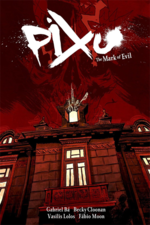 Pixu: The Mark of Evil
Pixu: The Mark of Evil
Writers/Artists: Gabriel Bá, Becky Cloonan, Vasilis Lolos, Fábio Moon
Publisher: Dark Horse
The creative team on Pixu is hard to ignore, each of the four talents enough to draw readers in for a new tale of horror and woe, and together presenting an absolute juggernaut of skill. After their 2008 Best Anthology Eisner win for 5, Gabriel Bá, Becky Cloonan, Vasilis Lolos and Fábio Moon teamed up again in 2009 for Pixu: The Mark of Evil. On the surface it’s a fairly standard haunted-house story. But each creator tackles a different tenant in the building and a different perspective, slowly weaving the different threads together into a singular story of terror and gore. There’s a decent amount of body horror and supernatural elements, but Pixu also features the terrible things that humans do to each other just with no interference from demons or monsters at all. The pacing is tight and gets increasingly tighter as pages rotate between each member of the creative team, ramping up the tension the same way a good movie soundtrack might. It’s a masterful example of what good collaboration can do, beyond just being scary and unsettling. —Caitlin Rosberg
![]()
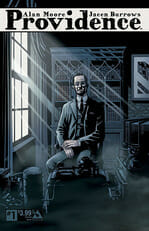 Providence
Providence
Writer: Alan Moore
Artist: Jacen Burrows
Publisher: Avatar Press
Alan Moore might be best known for works like Watchmen and The League of Extraordinary Gentlemen, but even his most mainstream superhero work has relied on some terrifying visions. His Killing Joke Batman tale was so horrifying, people are discussing a few pivotal scenes to this day, and he reintroduced Swamp Thing as a southern gothic hero before the words “The Yellow King” were uttered anywhere near a TV set. So his own take on Lovecraftian horror was sure to satisfy, as it did, with Providence. Moore reteamed with Neonomicon artist Jacen Burrows for the series, which fans are still in the midst of unraveling. The Lovecraft-inspired tale is creepy enough on the surface, but it’s also the best kind of horror comic—one that’s inclusive, yet not stopping Moore diehards from digging into every twist, turn and buried reference. —Tyler R. Kane
![]()
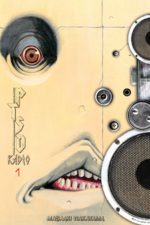 PTSD Radio
PTSD Radio
Writer/Artist: Masaaki Nakayama
Publisher: Kodansha Comics
Without fail, whenever I put out a call for scary comics, Masaaki Nakayama’s name gets uttered like he’s an insider secret—an underground favorite only known by the cool kids. Kodansha has translated five volumes of his work into English so far, and the structure of PTSD Radio fits neatly with Nakayama’s vibe as the near-urban-legend of horror manga. While there are recurring themes and plots throughout the series, PTSD Radio is better thought of as a collection of micro-frights than as a cohesive story or collection of stories. Characters are nonexistent and chapter text is nonsensical, but Nakayama’s penchant for grotesquely morphed faces and bodies, inescapable horrors and…really creepy hair…add up to a surprisingly potent brew of unease. Nakayama also manages to build to jump scare after jump scare, especially if you’re reading digitally without any warning as to what the next page might bring. Jump scares may feel cheap on film, but they’re darn hard to pull off—and perhaps even more unsettling—in comics. —Steve Foxe
![]()
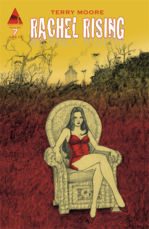 Rachel Rising
Rachel Rising
Writer/Artist: Terry Moore
Publisher: Abstract Studio
Nothing wakes you up quite like realizing you’re in your own shallow grave, and that’s what happens in the opening issue of Eisner-winner Terry Moore’s otherworldly Rachel Rising. What started off as a Kafka-esque exploration of relationships and mortality evolved into a long-running tale about all-things spooky—making it clear that Moore’s audience isn’t just enamored with his haunting art or on-page body count. They’re genuinely invested in these characters, too. —Tyler R. Kane
![]()
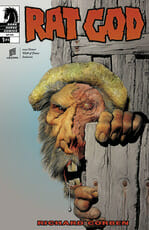 Rat God
Rat God
Writer/Artist: Richard Corben
Publisher: Dark Horse Comics
Any Richard Corben horror joint could make this list, including his excellent Poe and Lovecraft adaptations and Hellboy: The Crooked Man, quite possibly the scariest Hellboy story to date, but Rat God gets a slight edge for being an original tale of terror. Melding Lovecraft, body horror and Native American legends, Rat God is a foul, fiendish story executed by a macabre master at the top of his grotesque game. —Steve Foxe
![]()
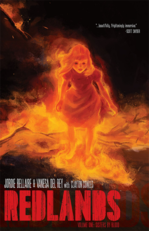 Redlands
Redlands
Writers/Artists: Jordie Bellaire & Vanesa R. Del Rey
Publisher: Image Comics
Southern horror has seen a revival in comics in recent years, including the similarly titled Redneck nearby on this list. Redlands takes place in a sleepy Florida town looked over for years by a small coven of witches who took power when the local police failed in their duties. Ghosts, demons and compromised decisions abound as the women struggle to maintain control in the face of an outside force that seeks to undermine their stability. Jordie Bellaire and Vanesa R. Del Rey make for an imposingly accomplished creative pairing, elevating what could have been a mediocre TV pitch into a compelling—and frequently frightening—tale of women under pressure. —Steve Foxe
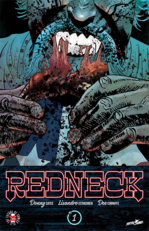 Redneck
Redneck
Writer: Donny Cates
Artist: Lisandro Estherren
Publisher: Skybound/ Image Comics
The lazy description for Redneck would be The Hangover with vampires, but this comic taps a far richer thematic vein. In this Southern-fried bloodsucker saga, a family of reformed, rural nosferatu drink cattle blood before sending the bovine corpses off to their BBQ joint in town. Tragedy (and mass quantities of alcohol) strikes, forcing the clan—including a creepy, wheelchair-bound patriarch in the attic—to either reconsider its place in society or embrace its predatory nature. Writer Donny Cates layers in themes that recall the social contract à la Hobbes’ Leviathan and the genocide-laced history of the southwestern United States, charting humanity’s bloodlust from manifest destiny onward. Rendered in jagged, disorienting black swaths by Lisandro Estherren, Redneck courses with volumes of personality and back story, and tearing into this epic-in-process should be an especially gratifying experience, especially if it includes more mind-reading juvenile vamps named Perry. —Sean Edgar
![]()
 Revival
Revival
Writer: Tim Seeley
Artist: Mike Norton
Publisher: Image Comics
Dubbed a “redneck noir,” Revival centers on a small town overrun with zombies. Not The Walking Dead-like zombies, mind you. Rather, these beings walk around and talk like normal people. In fact, unless you’d witnessed their resurrection firsthand, you’d never guess there was anything amiss. That is, until the newly un-alive start acting out in bizarre, violent ways. Revival’s brilliance lies in how it focuses just as much on the emotional drama surrounding the revivals as in the effective horror set pieces it creates. Like the best TV, the world only becomes more defined and the story richer with each new installment. —Mark Rozeman
![]()
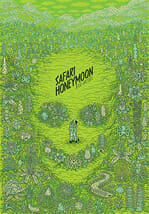 Safari Honeymoon
Safari Honeymoon
Writer/Artist: Jesse Jacobs
Publisher: Koyama Press
Though it’s not a strictly a horror comic per se, Jesse Jacobs’ account of a couple on a hunt for increasingly bizarre wildlife has enough moments of body horror to make David Cronenberg devotees clap their hands together in delight. Worms, infections and tongue-replacing parasites abound in this graphic novel-and, once you’ve read it, in your subconscious as well. —Tobias Carroll
![]()
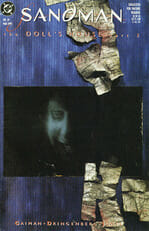 The Sandman
The Sandman
Writer: Neil Gaiman
Artists: Sam Kieth, Mike Dringenberg, Others
Publisher: Vertigo/ DC Comics
Neil Gaiman’s transcendental comic epiphany The Sandman invited readers into a dreamscape that sampled from a litany of genres, but many early issues leaned far more nightmare than dream. Two issues stand out in their chilling stature, though: “24 Hours” and “Collectors.” The former charts the state of a diner as it descends into madness when a D-list villain welds a reality-warping gem. “Collectors” covers a “Cereal Convention” at Empire Hotel, offering Gaiman the chance to compare undernourished comic conventions to gatherings in which unhinged killers trade advice and anecdotes. The fact that men and women indulge in reckless slaughter at the whim of a renegade, eye-devouring nightmare is no less assuring because it gives them an excuse; it’s harrowing because they’re powerless to resist. —Sean Edgar
![]()
 Severed
Severed
Writers: Scott Snyder & Scott Tuft
Artist: Attila Futaki
Publisher: Image Comics
A few years ago, I chatted with Scott Snyder about horror comics and their inability to generate surprise. I proposed that loose groups of panels lack the linear bang of prose or film when it comes to big reveals and twist endings. Snyder agreed with me on the phone, but then completely proved me wrong a week later when I read through Severed, the author’s nostalgic thriller about a cannibal bogeyman who assumes various identities to hunt children. The pacing and structure builds immaculately, climaxing with primal terror and psychological angst between a young boy and a monster who’s slowly become his family. —Sean Edgar
![]()
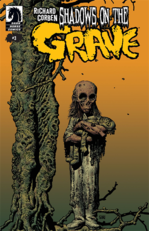 Shadows on the Grave
Shadows on the Grave
Writer/Artist: Richard Corben
Publisher: Dark Horse
Writer/artist Richard Corben’s contribution to horror comics can’t be praised enough. His signature style of dynamic lighting and decaying texture has graced titles ranging from Creepy and Eerie to Heavy Metal and Hellboy in a career that spans half a century. No other artist has been able to imitate his morbid facial expressions and surreal landscapes of fog and skeletons, and nor should they. Publisher Dark Horse has served as the artist’s modern home, releasing original tales (Rat God) and adaptations (The Conqueror Worm) throughout the past decade. But Shadows on the Grave may be Corben’s most evocative modern work: a sprawling anthology whose only constraint is its creator’s ghoulish imagination. Aside from a multi-part Greek tragedy, most stories average around six pages, and like the best horror, refuse to over-explain the occult violence that punctures each twist. Why a sentient graveyard swallows a brusque traveler or what the humanoid swamp rat is doing to that man is only for Corben to know, and for his art to reveal the most terrifying angles, amplifying the mystique to keep your nightmares thriving. —Sean Edgar
![]()
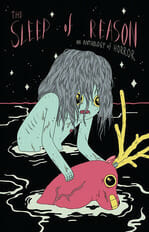 The Sleep of Reason
The Sleep of Reason
Editor: C. Spike Trotman
Publisher: Iron Circus Comics
The pitch for Smut Peddler creator C. Spike Trotman’s horror anthology is that its 26 black-and-white short stories contain no familiar terrors: no vampires, no werewolves, no easy solutions. Familiar names Carla Speed McNeil, KC Green and Langdon Foss mingle with rising cartoonists like Melanie Gillman, Blue Delliquanti, and Brittney Sabo for a tome that relies heavily on a gnawing sense of unease and discomfort rather than shock scares and gore. If you’re tired of seeing the same horror tropes perpetually recycled, The Sleep of Reason produces entirely new monsters to keep you up at night. —Steve Foxe
![]()
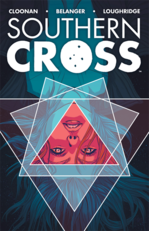 Southern Cross
Southern Cross
Writer: Becky Cloonan
Artist: Andy Belanger
Publisher: Image Comics
Calling Southern Cross a comic version of Twin Peaks in space may be reductive, but it’s not inaccurate. Imagine a narrative with all the interpersonal intrigue of Battlestar Galactica, the tense terror of Alien and the twisted mystery of Lynch and you’re just starting to scrape the surface of Becky Cloonan and Andy Belanger’s cosmic descent into hysteria. Digging toward the heart of a mystery involving the death of her sister, protagonist Alex Braith sees things that aren’t easy to explain or ignore. Cloonan, an artist herself, exercises precise, taut timing, and Belanger complements the claustrophobic script with uncomfortably intimate panels. The series also abounds in great Sorkin-style walk-and-talks that balance the visceral gore, and the sense of imminent danger from both within the ship and outside it holds readers in perfect suspense. —Caitlin Rosberg
![]()
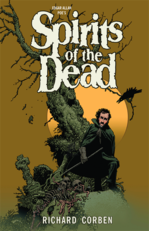 Edgar Allan Poe’s Spirits of the Dead
Edgar Allan Poe’s Spirits of the Dead
Writer/Artist: Richard Corben
Publisher: Dark Horse
Richard Corben has lent his iconic art to everything from Lovecraft to Luke Cage, but the living legend’s take on the work of ill-fated horror maestro Edgar Allan Poe stands out as a match made in Hell (in a good way). Corben’s anguished figures and oftentimes-restricted color palette perfectly channel Poe’s tortured protagonists as they tumble down the road to madness. This ghastly deluxe volume includes Poe tales both popular and obscure, including “The Raven” and “The Murders in the Rue Morgue”—the latter of which makes particularly good use of Corben’s talent for making the mundane grotesque. —Steve Foxe
![]()
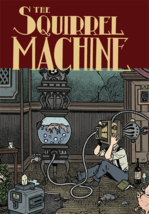 The Squirrel Machine
The Squirrel Machine
Writer/Artist: Hans Rickheit
Publisher: Fantagraphics
Like the equally inscrutable Al Columbia, Hans Rickheit’s work often reads like a discomforting tonal poem rather than a clear and cohesive narrative. The Squirrel Machine indulges Rickheit’s fascination with the meeting of flesh and metal (a classic theme of body horror) as two young 19th-Century boys make music out of animal corpses and off-kilter Victorian technology, rendered in Rickheit’s immaculately detailed inkwork. Like a collaboration between David Cronenberg and Damien Hirst, The Squirrel Machine is a disturbing plunge into a gifted, singular mind. —Steve Foxe
![]()
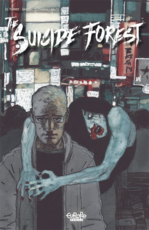 The Suicide Forest
The Suicide Forest
Writer: El Torres
Artist: Gabriel Hernandez Walta
Publisher: Europe Comics/ IDW Publishing
The reputation of Japan’s Aokigahara forest as a popular suicide destination has inspired numerous American film flops, and at least two excellent horror comics: a volume of I Am a Hero, also on this list, and El Torres and Gabriel Hernandez Walta’s The Suicide Forest. This 2011 comic follows two protagonists: a gaijin whose distraught girlfriend commits suicide and comes back to haunt those she feels were responsible, and one of Aokigahara’s experienced rangers, gifted in navigating the dense foliage and in dealing with the forest’s more permanent residents. Torres and Walta similarly dealt with the barrier between life and afterlife in The Veil, but their respectful handling of an often-exploited source inspiration gives The Suicide Forest a slight edge over that volume, and Walta’s watercolor-esque style lends itself perfectly to the oppressive gloom of Aokigahara. —Steve Foxe
![]()
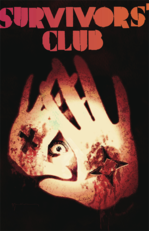 Survivors’ Club
Survivors’ Club
Writers: Lauren Beukes & Dale Halvorsen
Artists: Ryan Kelly & Inaki Miranda
Publisher: Vertigo/ DC Comics
Famed novelist Lauren Beukes’ first “ongoing” comic with co-writer Dale Halvorsen and artist Ryan Kelly didn’t end up going on for too long, but the scant nine issues Vertigo published of Survivors’ Club reveal a high concept worth revisiting. In 1987, a wave of children encountered supernatural threats that ring familiar to any horror nut: vengeful Japanese ghosts, vampires next door, dolls with wills of their own. Decades later, one of the survivors brings the others together to confront the return of an occult force from their youth. The finale (which clearly came unexpectedly soon) introduces a complication to the lore that deserves expansion, but the extant story, capably illustrated by Kelly and fill-in artist Inaki Miranda, is a treasure trove of references for fans of the genre. Here’s hoping the concept survives for a sequel. —Steve Foxe
![]()
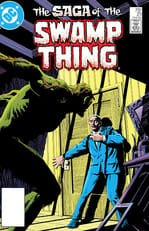 Swamp Thing
Swamp Thing
Writer: Alan Moore
Artists: John Totleben, Stephen Bissette, Rick Veitch, Others
Publisher: Vertigo/ DC Comics
Alan Moore didn’t just take over writing for Swamp Thing — he recreated him. He told us everything we thought we knew about the walking, talking mass of plant matter was wrong. Moore also brought a great deal of humanity to the Swamp Thing, and injected environmentalist issues into the monster series. From werewolves to aliens, there was no shortage of horror under Moore’s guidance, but some of the most chilling moments in the series were purely psychological. The Swamp Thing spends a large portion of the run struggling with his identity, trying to understand how much of the former humanity of Alec Holland still survives underneath his flora. —Robert Tutton
![]()
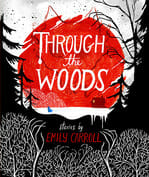 Through the Woods
Through the Woods
Writer/Artist: Emily Carroll
Publisher: Margaret K. McElderry Books
Each story collected in Through the Woods is worth the price of entry. A devotee of Junji Ito, cartoonist Emily Carroll serves up a hypnotic mixture of revulsion and dread, crafting stories that operate on multiple levels of horror. They appeal to both the horror fans who enjoy the build of tension and those who enjoy its cathartic release. “The Nesting Place” is the collection’s zenith, an example of Carroll’s ability to balance pure repulsion and compelling curiosity. Her stark compositions, her elaborate layouts, the color palette influenced by bloated, festering corpses—Emily Carroll makes old-fashioned storybooks that are, most assuredly, not for kids. Her heavily fluid, cartoonish art may make the strength of her horror chops surprising, but she manipulates that aesthetic to subvert the genre’s tropes. —Shea Hennum
![]()
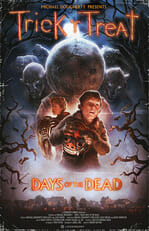 Trick ‘r Treat: Days of the Dead
Trick ‘r Treat: Days of the Dead
Writers: Michael Dougherty, Todd Casey, Zach Shields, Marc Andreyko
Artists: Fiona Staples, Stephen Byrne, Stuart Sayger, Zid
Publisher: Legendary
Though he’s scripted superhero tentpoles like X-Men 2, Superman Returns and X-Men: Apocalypse, Michael Dougherty far prefers fangs and masks to tights and capes. His 2007 celluloid Halloween anthology, Trick ‘r Treat, paid glorious homage to the golden age of horror comics, with chilling tales that recalled Creepy and Tales From The Crypt. Dougherty returns with the co-writers of his yuletide nightmare Krampus for brand new tales in the Trick ‘R Treat universe. Unrestrained by a movie budget, the four narratives span centuries, with tales flitting between the Irish witch trials, the expansionist west, old timey noir and a story set in the present. —Sean Edgar
![]()
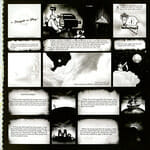 “The Trumpets They Play!”
“The Trumpets They Play!”
Writer/Artist: Al Columbia
Publisher: BLAB!
Getting your hands on an Al Columbia comic is as much of a horror story as reading one, thanks to his sporadic output and the general inaccessibility of the alternative presses that publish his work. Dig into his Wikipedia page and you’ll be half-convinced his very existence is an elaborate Creepypasta. Thankfully, Columbia is real, and his distorted version of reality is uniquely uncomfortable. Working primarily in a style that could only be described as “Walt Disney slaughters Max Fleischer and uses his blood for ink,” Columbia’s nightmare tales, from the recurring unsettling siblings Pim and Francie to “I Was Killing When Killing Wasn’t Cool,” leave you feeling violated, even…unsafe. If you can only commit to tracking down one tale, make it his Biblical epic “The Trumpets They Play!” —Steve Foxe
![]()
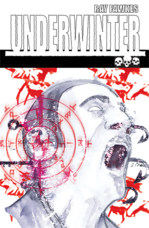 Underwinter
Underwinter
Writer/Artist: Ray Fawkes
Publisher: Image Comics
Ray Fawkes’ solo series is pure Italian horror: a down-on-their-luck quartet of musicians accepts a highly questionable gig at a remote estate, with explicit instructions not to remove their vision-obscuring masks. It doesn’t take a supernatural gift to guess what happens next, but the delight is in the pitch-perfect execution. Fawkes’ abstract, painted style has never been a better fit for his subject matter, vibrating somewhere between Francis Bacon and Bill Sienkiewicz. “Haunting” is overused when describing horror, but there are few words better applied to Fawkes’ work. As in the greatest Dario Argento and Mario Bava films, the color red is all but its own character throughout the pages of Underwinter, signaling the bloody consequences of an infernal bargain broken. —Steve Foxe
![]()
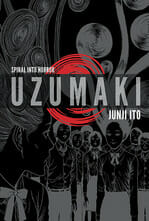 Uzumaki
Uzumaki
Writer/Artist: Junji Ito
US Publisher: VIZ Media
Junji Ito is far and away the undisputed king of horror manga, both in his native Japan and abroad. Ito’s themes run deep, particularly the self-destructive inevitability that drives many of his characters to their doom, a trope on full display in what most consider his finest work, Uzumaki. The premise sounds just absurd enough to elicit an uncomfortable laugh: the inhabitants of a small town find themselves obsessed with spirals. From this silly start a tremendously unsettling narrative unspools, with eyes spiraling back into heads and men breaking their bones to imitate the alluring shape of their obsessions. Any other (legal!) translation is equally essential for horror buffs, but Uzumaki is absolutely Ito’s long-form masterpiece. —Steve Foxe
![]()
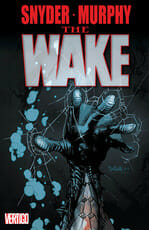 The Wake
The Wake
Writer: Scott Snyder
Artist: Sean Gordon Murphy
Publisher: Vertigo/ DC Comics
The Wake may be the best ‘80s creature feature that never was. Much like he did in American Vampire and Severed, writer Scott Snyder dives deep into the nostalgia well (and the Arctic Ocean) to drum up a yarn brimming with escapism and otherworldly threats. The maxi-series’ first half feels ripped straight from the Reagan Era, if only by osmosis. Mysterious Cold War bureaucracies, grotesque sci-fi fiends and a strong female protagonist all allude to some vintage cinema homage to works like The Abyss and The Thing. With a finale that trips headfirst into a Terry Gilliam-esque maritime post-apocalypse, The Wake isn’t just one of the most entertaining horror experiments, but one of the most creative. —Sean Edgar
![]()
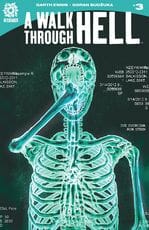 A Walk Through Hell
A Walk Through Hell
Writer: Garth Ennis
Artist: Goran Sudžuka
Publisher: AfterShock
In the glib shorthand that pop-culture fans and aficionados use to convey tone and subject as quickly as possible, A Walk Through Hell reads like the lovechild of X-Files and Twin Peaks with some Hannibal thrown in for color and eviscera. There’s a weird mystery, some FBI agents and even five issues in it’s not really clear what’s going on—but it’s hard to look away. Garth Ennis isn’t exactly an unknown quantity as a comics writer, and the book comes with a level of gore and horror that’s right in line with his previous work. The terror that the main characters face is just as much internal as it is external, buried in secrets and monstrousness that’s only glimpsed at. Goran Sudžuka clean, crisp artwork give the violence on the page a frankness and brutality that might be lost with something a bit more stylized. It’s rated 17 and up for good reason, and though it’s not yet evident exactly how the tangled mess of law enforcement failures relates to the weird warehouse that’s making everyone do unspeakable things, Ennis and Sudžuka have made it clear they’re taking readers on a horrific ride to get there. —Caitlin Rosberg
![]()
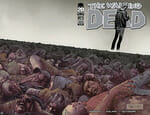 The Walking Dead
The Walking Dead
Writer: Robert Kirkman
Artists: Charlie Adlard, Tony Moore
Publisher: Skybound/ Image Comics
Guess what? If pathogen-driven decomposing cannibals overrun the world, humans still come out as the biggest monsters! Robert Kirkman deserves recognition for some wonderful world building in the saturated genre of zombie horror, but hell, his human antagonists are the most terrifying facet of The Walking Dead. Like a subverted hybrid of Lord of the Flies and Leviathan, the social rule established by villains like The Governor and Negan begs the question if human collusion is preferable to nomadism. Whether it be through Gladiator-style zombie fights or corporal punishment via clothes ironer, the biggest scares in this book are way more Takashi Miike than George Romero. For ex-sherif Rick Grimes and his band of wandering refugees, the only true home they’ve found is each other. —Sean Edgar
![]()
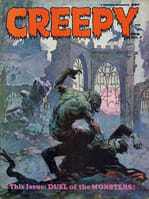 Warren Comics Archives: Creepy & Eerie
Warren Comics Archives: Creepy & Eerie
Writers/Artists: Various
Publisher: Warren, Dark Horse, Fantagraphics
The Comics Code Authority may have sent EC and its striking vintage horror to an early grave, but James Warren and a small army of editors, writers and illustrators picked up the slack through legal loopholes. So you’ll pardon Paste for listing a few magazines in this list, as Creepy, Eerie and Vampirella aren’t comics with their anthology setup, monochrome art and inflated dimensions. Legal semantics aside, these horrific vintage tales incubated such talent as Doug Moench, Alex Toth, Frank Frazetta, Richard Corben, John Severin and many more, as well as introducing American readers to the Spanish illustrators at Selecciones Illustrada. —Sean Edgar
![]()
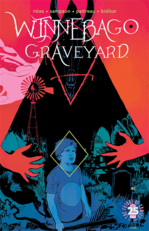 Winnebago Graveyard
Winnebago Graveyard
Writer: Steve Niles
Artist: Alison Sampson
Publisher: Image Comics
Parents have scared teens for ages with details of childbirth, but damn if Steve Niles and Alison Sampson concoct a new version of labor in Winnebago Graveyard that would make the most seasoned OBGYN faint. Niles has built a comics library of dread over the course of his career, including genre touchstones 30 Days of Night and Freaks of the Heartland. In this comic, line artist Alison Sampson and colorist Stephane Patreau take that legacy of twisting darkness and fear on a psychedelic road trip into small-town hell. In a political climate where rural Americana has been depicted as a sect filled with violent, religious extremists, the subtext of this comic is especially resonant. The debut issue revolves around a family of three that ventures into a Gothic carnival adorned with pentagrams, fleeing into a German surrealist nightmare after their RV disappears. At a terse four issues, Winnebago Graveyard marries the vulnerability of being desperately lost with ruralphobia, and it is absolutely horrifying. —Sean Edgar
![]()
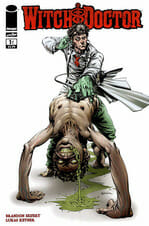 Witch Doctor
Witch Doctor
Writer: Brandon Seifert
Artists: Lukas Ketner
Publisher: Skybound/ Image Comics
The first title under Robert Kirkman’s Skybound umbrella, Witch Doctor slings an inventive twist on the modern shaman. Unlike other supernatural anti-heroes John Constantine or Doctor Strange, titular witch doctor Vincent Morrow lives up to his namesake, taking full advantage of the MD on his signature. Morrow and his crew, including the creepy Penny Dreadful and straight man Eric Gast, fight the powers of darkness through modern science. The most inspired twist may be a baddie influenced by a sea louse that replaces fishes’ tongues. It’s a shame we’ve only seen two miniseries and a one-shot from writer Brandon Seifert and artist Lukas Ketner; hopefully the good doctor will make a house call in the near future. —Sean Edgar
![]()
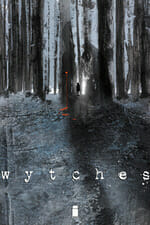 Wytches
Wytches
Writer: Scott Snyder
Artists: Jock
Publisher: Image Comics
Scott Snyder transforms the primal anxieties of fatherhood into this creepy, suffocating reimaging of Satan-worshipping crones. Like his revamps of sea monsters in The Wake and bloodsuckers in American Vampire, Snyder drills into history and neurosis for a renewed take both clever and profound. In this case, YA novelist Charlie Rook squares off against ancient, slimy beings who trade potions for human lives. Beneath this engrossing fiction lies the universal struggle of one father ensuring that his daughter comes first—no matter the cost. Jock’s scratchy, decaying textures cast a dirty feel over the whole production, producing one of the most memorable and heart-felt horror comics of this generation. Now if only they can hurry up on volume two. —Sean Edgar
GET PASTE RIGHT IN YOUR INBOX
The best music, movies, TV, books, comedy and more.
-

-

-

-

-

-

-

-

-

-

-

-

-

-

-

-

-

-

-

-

-

-

-

-

-

-

-

-

-

-

-

-

-

-

-

-

-

-

-

-

